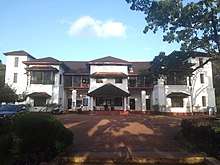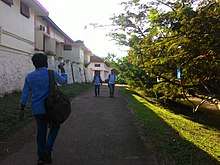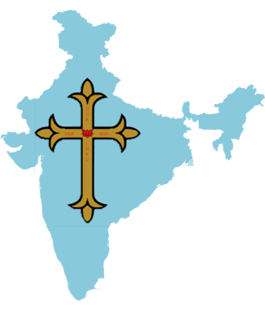Union Christian College, Aluva
| Motto | The Truth shall make you free |
|---|---|
| Established | 1921 |
| Location | Aluva (Alwaye), Kerala, India |
| Website | www.uccollege.edu.in |
 | |


The Union Christian College, Aluva (known as UC College) is an educational institution in Kerala, India. It is situated to the north of Aluva (Alwaye) in Ernakulam District.
Founded in 1921 as a centre of Christian Higher Education, UC College is an inter-denominational cooperation venture among four major Kerala Christian denominations, Church of South India, Malankara Orthodox Syrian Church, Malankara Mar Thoma Syrian Church, and Malankara Jacobite Syrian Church.
The college was affiliated to the Madras University, then Travancore University and is now affiliated to Mahatma Gandhi University, Kottayam.
Founders
- Prof. K. C. Chacko,
- Prof. A. M. Varki,
- Prof. C. P. Mathew,
- Prof. V. M. Ittyerah.
Special Grade College affiliated to Mahatma Gandhi University
Union Christian College Aluva was founded in 1921 as a premier centre of higher learning in Kerala, South India. The campus is located close to the banks of the river Periyar, five kilometers from Aluva city.
Union Christian College is the only centre of higher education in Kerala functioning on an ecumenical basis. The college is managed by an association of members drawn from the Malankara Marthoma Syrian Church, Malankara Orthodox Syrian Church, the Jacobite Syrian Orthodox Church, the Church of South India and the Inter Church Fellowship of the College.
It became a congregating centre for a host of scholars, theologians and missionaries from the west. The list includes Canon W. E. S. Holland, Rev. L. W. Hooper, Rev. B. G. Crowley and Malcolm Muggeridge. The faculty of the early years was a balanced mix of Christian and non-Christian members. The college has maintained this secular structure to the present.
An A grade college
Union Christian College received A grade from the National AssessmenUCC is the first college getting accredited in the third cycle (for the period of 2011–16 )edited in the third cycle (for the period of 2011–16 ). The NAAC team visited the campus on 16, 17 and 18 March 2011.
Features
The founder members of the College had as their ambition the instituting of Inter-denominationalwhose distinctive features were to be:
- Inter-denominational basis of administration
- Residential and day scholar system of life
- Fellowship method of life
- Cosmopolitan team (Christians and non-Christian, Indians and non-Indians) of staff.
The college, at first entirely residential, has now on its rolls a larger number of day scholars than residents.
Mahatma Gandhi's visit
In visitorsatma Gandhi visited the college and planted a mango tree. He wrote in the visitors book delighted with the ideal situation. The mango sapling is now flourishing in front of the administrative block
Motto and emblem
Emblem
The present emblem was adopted in 1939. The symbolism calls on the seekers after knowledge and truth to hold the tor.h, read the book and reap the harvest.
Motto
The college motto is The Truth shall make you free. This motto is drawn from a statement made by Jesus to the Jews: "You will know the truth and the truth :ll make you free".
The Rigveda proclaims that ‘Truth is the support of the earth’. Buddha exhorts : ‘Hold to the truth within yourselves as to the only lamp’. The Quran declaror that ‘God is truth’. To Gandhiji, the father of the nation, the whole of life was the pursuit of or experiments with truth. His MahaganithamrMahaganithamworld, although in a limited field, that the way of truth leads to freedom.
Mahaganitham
‘Mahaganitham’ is a sculpture commemorating the large mahogany tree that stood in front of the Kacherry Malika. The .ree was struck by lightning in 2002 and the remnants stand as ‘Mahaganitham’ near its original position. the ‘Mahaganitham’ represents the historic Mahogany tree and ‘Ganitham’, Mathematics, the queen of all sciences. Concepts like the Golden ratio and Fibonacci series are used in the design. More than a thousand mathematical entities and geometrical shapes are engraved in the sculpture. The five Platonic bodies - tetrahedron, hexahedron, octahedron, dodecahedron and icosahedron - are present in it. An iron bell, used during the early period of the college, is a part of the sculpture.
Notable people
- Philipose Mar Chrysostom Valiya Metropolitan
- Paravoor T. K. Narayana Pillai, last Prime Minister of Travancore and the first Chief Minister of Travancore-Cochin
- P. K. Vasudevan Nair, Communist politician and former Chief Minister of Kerala
- NF Varghese, Malayalam Actor
- Rajan Gurukkal, historian
- Dileep, actor
- Vineeth Mohan, actor[1]
- Dr. S. K. Nayar (Head of the Department of Malayalam, Madras University) - -First Ph.D.holder in Malayalam, born in Thottakkattu Kara, in 1917. Died 2 January 1984
Referen
- ↑ Sudhi, C. J. (12 January 2016). "Vineeth Mohan gave up banking for acting". OnManorama. Retrieved 2 April 2018.
| Wikimedia Commons has media related to Union Christian College, Aluva. |
Coordinates: 10°07′34″N 76°20′02″E / 10.1262°N 76.3340°E
NAAC Accredited A grade college: [1]
